Bahrain Biofertilizers Market Outlook to 2030
By Microbial Type, By Formulation, By Application Method, By Crop/End-use, By Certification Regime, By Distribution Channel, and By Region
- Product Code: TDR0232
- Region: Middle East
- Published on: August 2025
- Total Pages: 110
Introducing the World's FirstPay-Per-Section Market Reports
Why pay for the full report when you need just a part?
Start Building Your Report
Scroll down to see available sections
Report Summary
The report titled “Bahrain Biofertilizers Market Outlook to 2030 – By Microbial Type, By Formulation, By Application Method, By Crop/End-use, By Certification Regime, By Distribution Channel, and By Region” provides a comprehensive analysis of the biofertilizers industry in the Kingdom of Bahrain. The study covers the overview and genesis of the market in an arid, saline-soil context shaped by desalinated/brackish irrigation and expanding controlled-environment agriculture. It details the overall market size in terms of revenue and volume, along with granular segmentation. The report maps trends and developments and examines the regulatory landscape. It incorporates customer-level profiling, analyzes issues and challenges and presents the competitive landscape with competition scenario, cross-comparison, opportunities, and bottlenecks. The study concludes with future market projections based on treated-area volumes, product mix, regional adoption curves, and cause-and-effect relationships, complemented by success case studies that highlight major opportunities and cautions for market entrants, distributors, and technology providers.
Bahrain Biofertilizers Market Overview and Size
The Bahrain segment of the GCC biofertilizer market is valued at approximately USD 36.8 million, based on the broader GCC total of USD 36.8 million reported for the region in 2024 and recognizing Bahrain as part of that aggregate. Growth over the 2019–2024 period is propelled by increasing demand for organic and environmentally friendly agricultural solutions, rising investments in sustainable farming practices, and government-led initiatives to reduce synthetic fertilizer usage, reinforced by R&D and soil‑health awareness campaigns across the GCC.
In the GCC region, Saudi Arabia leads the biofertilizer market due to its expansive agricultural programs, stronger R&D infrastructure, and significant investments under initiatives like the Green Saudi Initiative. Bahrain, while smaller, contributes meaningfully due to its concentrated greenhouse developments, emphasis on food security, and policy frameworks encouraging sustainable farming, positioning it as a high‑potential adopter within the GCC agritech ecosystem.
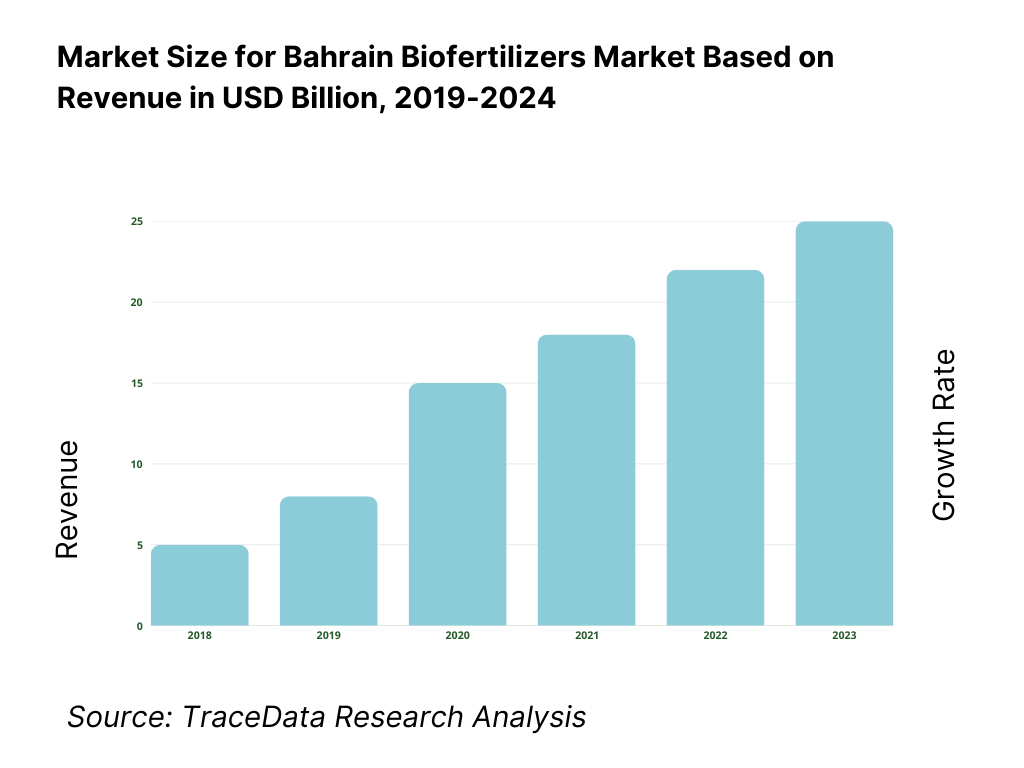
What Factors are Leading to the Growth of the Bahrain Biofertilizers Market:
Soil salinity mitigation: Bahrain farms almost entirely under irrigation—4,060 hectares actually irrigated and 3,730 hectares equipped—concentrated in date palm, vegetables, and fodder systems, where salt stress is chronic. Non-conventional water dominates supply: 0.24 km³ of desalinated water was produced and 0.01 km³ of treated municipal wastewater was directly reused for irrigation, while total withdrawals reached 0.43 km³ with 0.14 km³ drawn by agriculture. High saline load is evidenced by groundwater quality in the main Khobar aquifer, with a mean TDS of 4,543 mg/L (min 1,540, max 9,616 mg/L). These hydrological realities make salt-tolerant microbial consortia and bio-ameliorants (e.g., halotolerant PGPR) operational necessities to maintain root-zone function and nutrient uptake.
Fertigation compatibility: Bahrain’s irrigated area already uses distribution methods conducive to fertigation and biofertigation: localized irrigation covers 430 hectares, sprinkler 150 hectares, and surface irrigation 3,150 hectares. With municipal demand drawing 0.28 km³ of withdrawals and groundwater providing 0.16 km³, precise dosing via fertigation is pivotal for water and nutrient-use efficiency. Non-conventional supply additions such as the government-announced Hamala brackish-water RO plant at 10 million gallons/day strengthen pressurized network reliability that fertigation rigs depend on. In parallel, the population base of 1,588,670 raises steady demand for domestic horticulture and fresh produce, incentivizing growers to adopt dose-controlled, microbe-enriched fertigation to stabilize yields in saline conditions.
Greenhouse & hydroponics expansion: Protected cultivation is structurally aligned with Bahrain’s climate and water profile. Heat episodes are intense: June 2024 recorded a mean maximum 41.6 °C and 21 days above 40 °C, with site highs of 48.6 °C—conditions that shift growers to greenhouses, net houses, and hydroponics where biofertilizers can be metered in recirculating nutrient solutions. On the supply side, irrigated land is near-universal: 4,060 ha actually irrigated vs 4,100 ha cultivated, and water stress is high, making closed-loop fertigation and bio-inputs attractive for nutrient efficiency and root health. Staple perennial output like 13,800 tonnes of dates underscores reliance on protected/perennial systems amenable to microbial inoculants and biostimulants.
Which Industry Challenges Have Impacted the Growth of the Bahrain Biofertilizers Market:
Summer heat – microbe viability: Thermal extremes shape product performance and logistics. The Meteorological Directorate reported June 2024 as the second hottest June on record with a mean temperature of 36.2 °C, mean maximum 41.6 °C, and 21 days exceeding 40 °C; peak site readings reached 48.6 °C the same month. In June 2023, the airport registered a 45.8 °C maximum with multiple observation points above 47 °C. Such sustained heat raises challenges for storage, transport, and field survival of living inoculants, mandating thermotolerant strains, cold-chain planning, and evening fertigation schedules to maintain viable colony-forming units (CFU) at application.
Chlorinated/desalinated water impacts: Irrigation mixes increasingly contain desalinated and treated sources. National water accounting shows 0.24 km³ of desalinated production and 0.01 km³ of direct treated municipal wastewater applied to irrigation, alongside 0.16 km³ groundwater abstraction. Municipal demand accounts for 0.28 km³ of withdrawals, reflecting a distribution grid where chlorination is standard for public health. Plant-safe residuals can still depress free-living microbial activity on contact, so growers often dechlorinate or buffer irrigation streams before dosing biofertilizers. Capacity expansions—e.g., Hamala RO at 10 MIGD and the commissioned Al Dur Phase-2 (227,000 m³/day)—increase availability of low-hardness water, but require microbial programs tuned to oxidants and low-ionic matrices.
Saline/brackish irrigation EC: Despite desalination, agriculture still taps brackish groundwater (0.16 km³ withdrawals). The Khobar aquifer monitoring shows mean TDS 4,543 mg/L with maxima near 9,616 mg/L, reflecting salinity levels that can depress rhizosphere enzyme activity and nitrogen fixation rates. Coastal waters around Bahrain also show high ambient salinity (west-coast averages above 52 practical salinity units in recent surveys), increasing seepage and salt-spray risks for peri-coastal plots. With 3,730 ha equipped and 4,060 ha actually irrigated, managing EC via dilution, gypsum/organic matter programs, and deploying halotolerant consortia becomes central to maintaining functional microbiomes during fertigation in greenhouses and open fields.
What are the Regulations and Initiatives which have Governed the Market:
Bahrain Fertilizer Law & Executive Bylaw—registration: Bahrain applies the GCC Law on Fertilizers and Agricultural Soil Conditioners (Law No. 38 of 2005) and its Executive Regulation (Resolution No. 89 of 2006) for product compliance. The Agricultural Health Directorate operates an official “Application for Registration of Fertilizer or Agricultural Soil Conditioner” e-service that issues conformity certificates against the executive regulation. For market access, dossiers must align with GCC specifications, enabling importers to circulate registered biofertilizers legally and traceably. The legal numbering (38/2005 and 89/2006) underpins due-diligence checks in distributor agreements and customs documentation for Bahrain.
Sampling at customs: Bahrain’s government portal details operational controls at entry points: importers must present a registration certificate from the Soil & Fertilizers Department, an import license from Plant Quarantine, and a sample-taking form. The Soil & Fertilizers Department may recommend sampling on arrival, with consignment data recorded on official forms and sent to accredited labs for analysis—procedures designed to verify label claims (e.g., viable counts) and screen contaminants. These steps formalize batch-level traceability and can add lead time to launches; suppliers should plan buffer inventory in the kingdom to accommodate compliance sampling cycles.
Plant Quarantine interface: Biofertilizer entry intersects plant quarantine rules via the GCC Agricultural Quarantine Law (Law No. 5 of 2003), administered locally by the Agricultural Health Directorate (contact points registered with the IPPC). Import workflows for “plants, plant products or other regulated articles” require licensing, and in fertilizer cases, linkage to the fertilizer registration certificate is mandatory per the Ministry service guidance. For distributors, aligning HS codes, import permits, and quarantine notifications in advance is critical to avoid holds at ports under the committee authorities formed by the ministry’s resolutions.
Bahrain Biofertilizers Market Segmentation
By Type of Biofertilizer: In the Bahrain (GCC) biofertilizer market, nitrogen‑fixing products dominate with about 45% share, owing to their direct impact on crop nutrient uptake and their versatility across cereals, greenhouse vegetables, and date palms—the latter being locally significant. These products tend to deliver the most immediate yield improvements in nutrient‑poor soils. Phosphate‑solubilizing types, follow closely due to their effectiveness in mobilizing essential phosphorus, a recurring limiting nutrient in arid soils. The remaining comprises potassium‑mobilizers and microbial consortia blends, appealing increasingly to premium horticulture and turf segments requiring multi‑nutrient support.
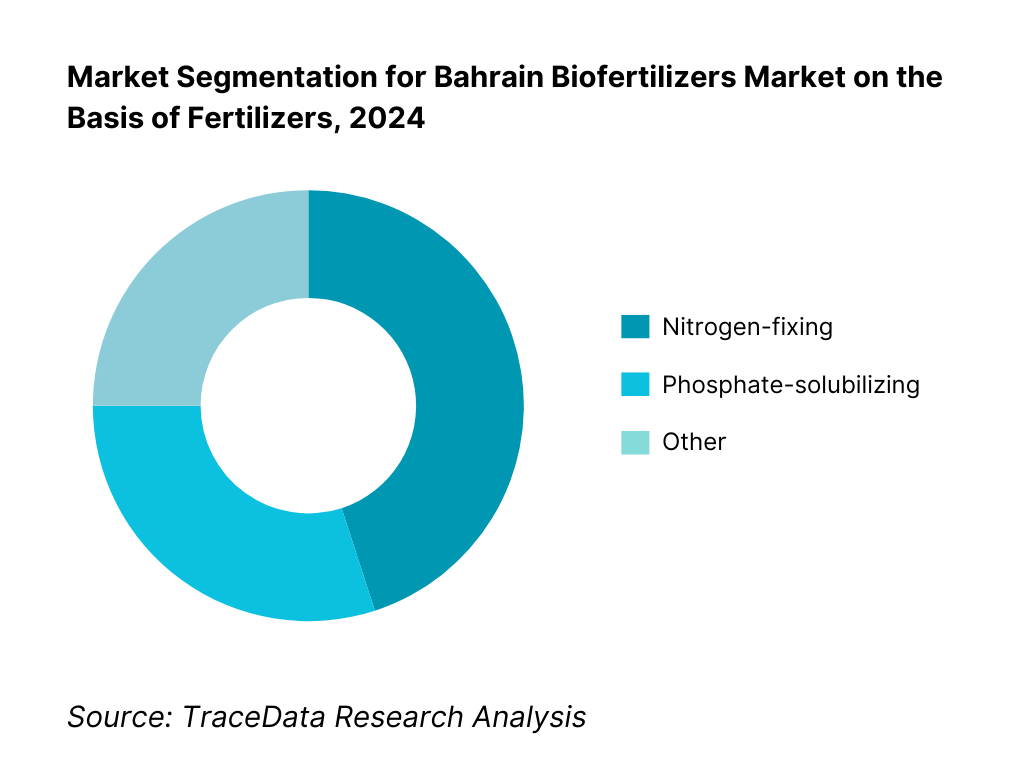
By Mode of Application: Seed treatment leads in Bahrain’s biofertilizer segment, as farmers prefer coating seeds to ensure early microbial colonization for optimal germination and establishment—especially critical under saline and arid conditions. Soil treatments leveraged in date‑palm planting and greenhouse beds where bulk microbial delivery to the root zone enhances soil fertility. The remaining comprises foliar sprays and specialized carrier or inoculant blends used in high‑value leafy greens and landscaping, offering tailored nutrient boosts or compatibility with fertigation systems in controlled‑environment agriculture (CEA).
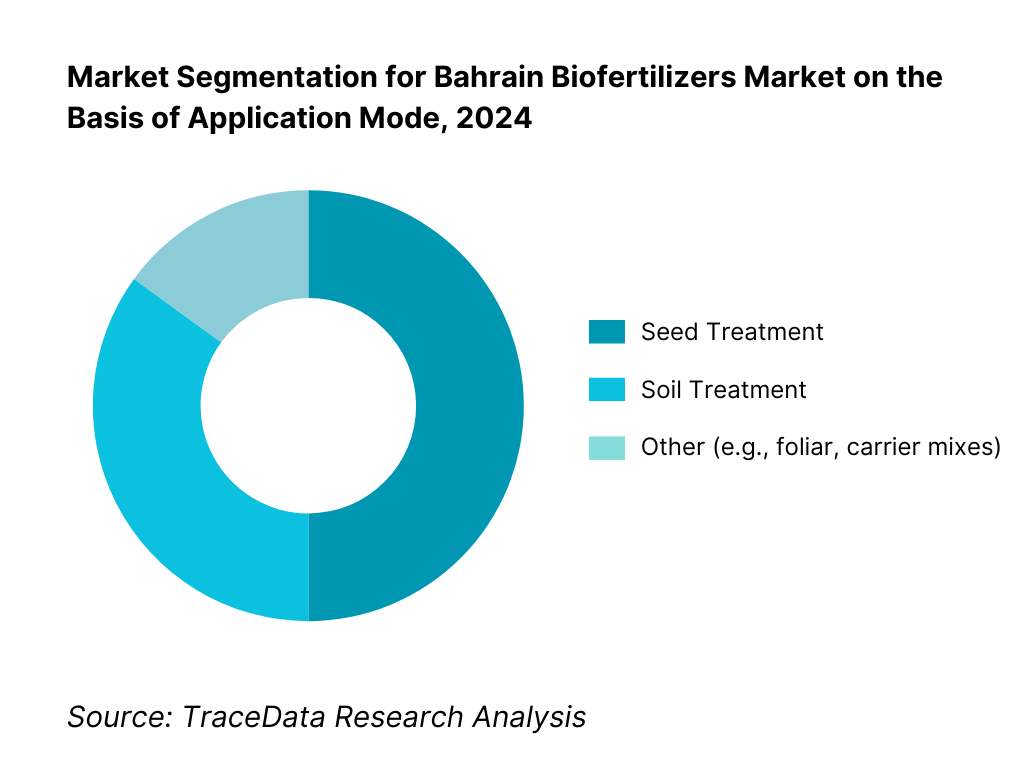
Competitive Landscape in Bahrain biofertilizer Market
The Bahrain biofertilizer market features a blend of local importers/distributors and regional/global microbial suppliers, reflecting a consolidated yet diverse competitive landscape. Local entities such as Bahrain Organic Products and Nature Organic Products dominate distribution through deep farm and landscaping penetration, while global technologists like Lallemand, Koppert, and Novonesis provide expertise in formulation and advanced microbial blends, underscoring a market shaped by international technical leadership coupled with local channel strength.
Name | Founding Year | Headquarters |
Bahrain Organic Products | 1997 | Manama, Bahrain |
Al Bakali General Trading BSC (C) | 1981 | Manama, Bahrain |
Alkhair Agricultural Centre WLL | 2002 | Manama, Bahrain |
Jassim Garden Centre | 1980 | Burhama, Bahrain |
Dar Aqua & Agriculture WLL | 2013 | Manama, Bahrain |
Koppert Biological Systems | 1967 | Berkel en Rodenrijs, Netherlands |
Lallemand Plant Care | 1903 | Montreal, Canada |
Novonesis | 2000 | Copenhagen, Denmark |
UPL | 1969 | Mumbai, India |
Rizobacter | 1977 | Pergamino, Argentina |
Symborg | 2010 | Murcia, Spain |
Valent BioSciences | 2000 | Libertyville, Illinois, USA |
Verdesian Life Sciences | 2012 | Cary, North Carolina, USA |
Stoller (now Corteva) | 1970 | Houston, Texas, USA |
BASF Agricultural Solutions | 1865 | Ludwigshafen, Germany |
Some of the Recent Competitor Trends and Key Information About Competitors Include:
Bahrain Organic Products: As one of the first local producers of organic fertilizers and soil conditioners in Bahrain, Bahrain Organic Products expanded its product range in 2024 to include biofertilizer blends targeted at date palm cultivation and municipal landscaping projects, strengthening its presence in sustainable agriculture.
Al Bakali General Trading BSC (C): A leading distributor of agricultural inputs in Bahrain, Al Bakali has increased its partnerships with global biofertilizer manufacturers in 2024, ensuring a wider portfolio of microbial solutions compatible with saline and arid soil conditions.
Nature Organic Products (Abdulla Nass Group): Known for its focus on organic and eco-friendly agricultural products, Nature Organic Products introduced liquid biofertilizers tailored for greenhouse vegetables in 2024, aligning with the country’s push toward controlled-environment farming.
Koppert Biological Systems: A global leader in biological crop solutions, Koppert strengthened its GCC distribution channels in 2024 by expanding its biofertilizer and biostimulant portfolio in Bahrain, targeting commercial greenhouse projects and high-value horticulture.
Lallemand Plant Care: Specializing in microbial inoculants, Lallemand increased its footprint in the Bahrain market in 2024 by launching mycorrhizal inoculants and PGPR strains designed to enhance salinity tolerance, catering to Bahrain’s water-scarce and high-salinity agricultural landscape.
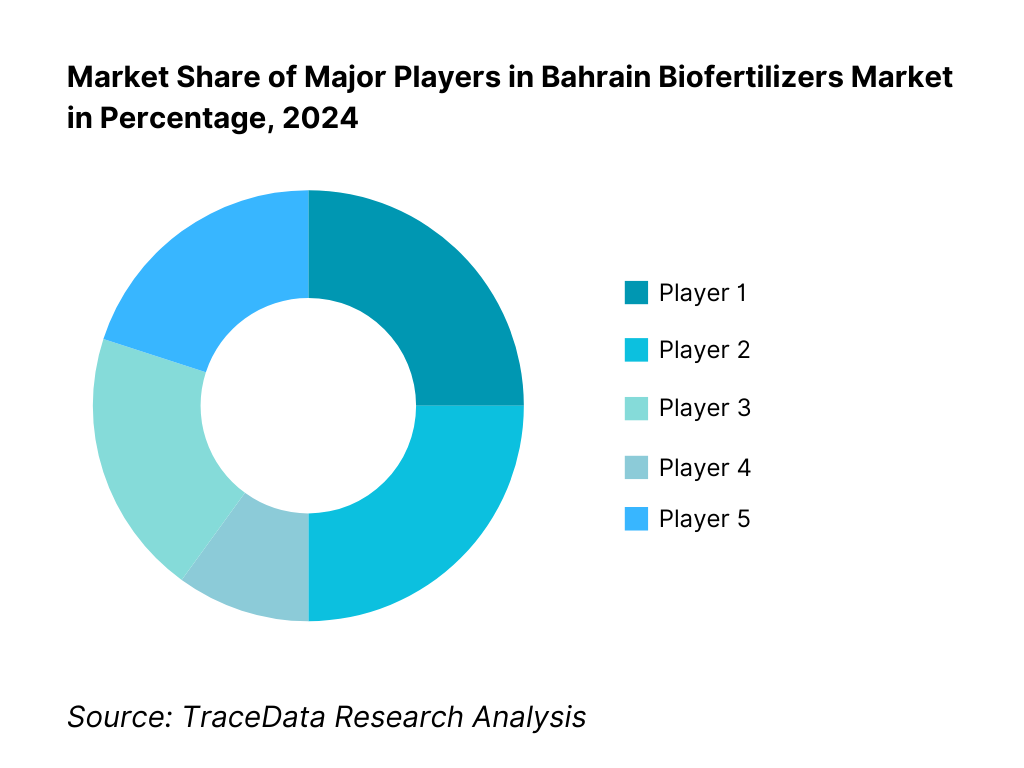
What Lies Ahead for Bahrain Biofertilizers Market?
The Bahrain biofertilizers market is anticipated to expand steadily toward 2030, supported by national food security objectives, the ongoing transition to controlled-environment agriculture (CEA), and stricter sustainability regulations. Growth will be fueled by the need to address soil salinity, optimize limited water resources, and align with GCC-wide environmental standards promoting organic and eco-friendly inputs.
Adoption of Salinity-Tolerant Microbial Solutions: With irrigation water often carrying high salinity and Bahrain’s groundwater exhibiting TDS levels above 4,500 mg/L, the future will emphasize biofertilizers built on halotolerant PGPR and mycorrhizal strains, enabling crop survival and yield stability in saline soils.
Integration with Fertigation Systems: As Bahrain’s irrigated land is nearly 100% dependent on localized or surface irrigation, fertigation-ready biofertilizers will dominate. The compatibility of liquid formulations and encapsulated inoculants with drip irrigation ensures efficient nutrient delivery, reduced losses, and higher microbial survival rates.
Expansion of Greenhouse & Hydroponics Farming: Bahrain is increasingly relying on greenhouse and hydroponic systems to mitigate extreme summer temperatures that often exceed 45 °C. The future of biofertilizers in the kingdom lies in supplying CEA operators with microbial blends designed for recirculating nutrient solutions and closed-loop farming models.
Regulatory Strengthening & Compliance-Based Differentiation: With Bahrain enforcing Fertilizer Law No. 38 of 2005 and its executive bylaws, suppliers that secure registrations, demonstrate conformity with GSO organic fertilizer standards, and provide clear CFU viability data will gain a competitive edge as compliance becomes a differentiator.
Leveraging R&D and Digital Platforms: The coming years will see R&D into microbial encapsulation, shelf-life extension under Bahrain’s high heat, and integration of digital advisory platforms to guide farmers and landscapers on correct biofertilizer use. This convergence of technology and biology will shape adoption and farmer trust.
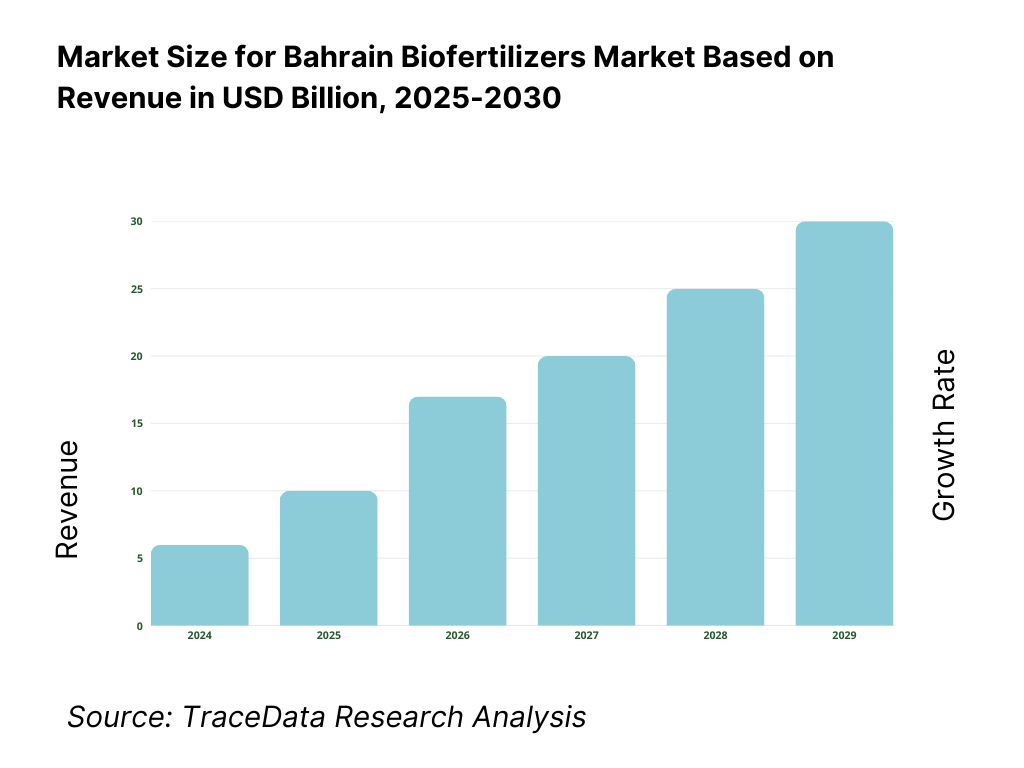
Bahrain biofertilizer Market Segmentation
By Biofertilizer Microbial Type
Nitrogen-fixers
Phosphate-solubilizing bacteria
Potassium-mobilizing bacteria
PGPR consortia blends
Mycorrhizal inoculants
By Formulation Type
Liquid formulations
Powder/granular formulations
Carrier-based (e.g., peat, lignite, compost)
Encapsulated beads / micro-capsules
By Application Method
Seed treatment
Soil/root drench
Fertigation (drip/fertigation injectors)
Foliar sprays & other delivery
By Crop / End-Use Segment
Date palm
Greenhouse vegetables
Open-field vegetables & forage
Turf / Golf / Landscaping
By Distribution Channel
Importers / Wholesalers
Agri-input Retailers
Landscaping Contractors / Golf & Municipal Buyers
CEA Project Integrators
Direct-to-farm / Digital Platforms
Players Mentioned in the Report:
Bahrain Organic Products (Middle East Agriculture & Animalism Co. WLL)
Al Bakali General Trading BSC (C)
Nature Organic Products (Abdulla Ahmed Nass & Sons WLL)
Alkhair Agricultural Centre WLL
AlWadi Agroserve
Al Reef Nursery
Jassim Garden Centre
Dar Aqua & Agriculture WLL
Desert Oasis Nursery Bahrain WLL
Koppert Biological Systems (via regional partner)
Novonesis (BioAg/Biosolutions)
Lallemand Plant Care
UPL – NPP (Biosolutions)
Rizobacter (via MEA partner)
Symborg (Corteva Biologicals)
Key Target Audience
Agribusiness investment funds
Biofertilizer importers/distributor executives
Controlled‑Environment Agriculture project developers
Landscape irrigation and turf management companies
Date‑palm plantation operators
Food security and agricultural development authorities (e.g., MMAA, NIAD)
Government and regulatory bodies
Investments and venture capitalist firms focused on ag‑tech and sustainable inputs
Time Period:
Historical Period: 2019-2024
Base Year: 2025
- Forecast Period: 2025-2030
Report Coverage
Choose individual sections to purchase. Mix and match as you like.
- -
- -
- $100
4.1 Delivery Model Analysis for Biofertilizers (imported finished products, GCC redistribution, local blending/packaging, direct-to-farm demos)-Margins, Preference, Strengths, Weaknesses
4.2 Revenue Streams for Bahrain Biofertilizers Market (product sales, distributor margins, demo projects, landscaping contracts, CEA turnkey deals, organic-certified premium pricing)
4.3 Business Model Canvas for Bahrain Biofertilizers Market (key partners, key activities, customer segments, value propositions, cost structure, revenue streams)
$2505.1 Imported Products vs. Local Production (market share, cost dynamics, viability challenges)
5.2 Investment Model in Bahrain Biofertilizers Market (greenfield manufacturing, GCC-based contract production, joint ventures with UAE/KSA players)
5.3 Comparative Analysis of Adoption Funnel (government projects vs. private greenhouse farms vs. landscaping tenders)
5.4 Biofertilizer Budget Allocation by Farm Size (smallholder farms, medium greenhouse clusters, large CEA projects/municipal landscaping)
$150- $100
- $200
8.1 Revenues, 2019-2024
$3009.1 By Market Structure (In-house composting vs. imported commercial biofertilizers)
9.2 By Biofertilizer Type (Nitrogen-fixers, Phosphate Solubilizers, Potassium Mobilizers, PGPR, Mycorrhiza)
9.3 By Crop Segment (Date Palm, Greenhouse Vegetables, Open-field Vegetables, Forage/Field Crops, Turf & Landscaping)
9.3.1 By Type of Greenhouse Crop (Tomatoes, Cucumbers, Leafy Greens)
9.3.2 By Type of Landscaping End-use (Golf courses, Parks, Municipal Landscaping, Private Gardens)
9.3.3 By Type of Palm Application (Nursery-stage inoculants, Field-stage soil inoculants)
9.3.4 By Type of Turf Biofertilizer (Liquid microbial blends, Mycorrhiza-based products)
9.4 By Farm Size (Smallholders, Medium farms, Large CEA projects)
9.5 By End-user (Commercial Farms, Landscaping Contractors, Government Demonstration Projects)
9.6 By Application Method (Seed treatment, Root dip, Soil drench, Fertigation, Foliar sprays)
9.7 By Certification (Organic-certified, Conventional/IPM-compliant)
9.8 By Region (Capital, Muharraq, Northern, Southern)
$40010.1 Farm & Landscaping Client Landscape and Cohort Analysis
10.2 Decision-making Process (factors: cost-benefit, viability in saline soils, technical support availability)
10.3 Effectiveness & ROI Analysis (yield increases, fertilizer cost reductions, water efficiency)
10.4 Gap Analysis Framework (awareness vs. adoption, trial vs. commercial conversion)
$50011.1 Trends and Developments (liquid formulations, fertigation dosing, consortium inoculants, GCC regulatory harmonization)
11.2 Growth Drivers (food security push, organic & residue-free demand, CEA growth, salinity management)
11.3 SWOT Analysis
11.4 Issues and Challenges (high temps, saline water, shelf-life, import dependency, regulatory approvals)
11.5 Government Regulations (registration, GSO standards, MMAA conformity, labeling, advertising claims)
$20012.1 Market Size and Future Potential for Digital/Online Agri-Advisory Platforms in Bahrain (apps, NIAD e-services)
12.2 Business Model and Revenue Streams (subscription, bundled with inputs, data services)
12.3 Delivery Models (mobile apps, agronomist networks, CEA integrators)
12.4 Cross Comparison of Leading Agri-Advisory Platforms (company overview, funding, reach, user base, revenue streams, partnerships)
$500- $250
- $150
15.1 Market Share of Key Players (import share, distributor reach, channel power)
15.2 Benchmark of Key Competitors (company overview, USP, strategies, number of agronomists, revenues, product portfolio, technology, best-selling inoculants, major clients, tie-ups, marketing strategy, recent developments)
15.3 Operating Model Analysis Framework (import-driven vs. local packaging vs. regional partnerships)
15.4 Gartner Magic Quadrant (vision vs. execution for Bahrain biofertilizer providers)
15.5 Bowmans Strategic Clock (competitive positioning of players: differentiation, cost, hybrid strategies)
$75016.1 Revenues, 2025-2030
$30017.1 By Market Structure, 2025-2030
17.2 By Biofertilizer Type, 2025-2030
17.3 By Crop Segment, 2025-2030
17.3.1 By Greenhouse Crops, 2025-2030
17.3.2 By Landscaping End-use, 2025-2030
17.3.3 By Palm Applications, 2025-2030
17.3.4 By Turf Biofertilizer Types, 2025-2030
17.4 By Farm Size, 2025-2030
17.5 By End-user, 2025-2030
17.6 By Application Method, 2025-2030
17.7 By Certification, 2025-2030
17.8 By Region, 2025-2030
$400- $250
- $250
Research Methodology
Step 1: Ecosystem Creation
We begin by mapping the ecosystem and identifying all demand-side and supply-side entities relevant to the Bahrain Biofertilizers Market. On the supply side, this includes global biofertilizer manufacturers, regional distributors, local agricultural retailers, government bodies such as the Ministry of Municipalities and Agriculture Affairs (MMAA), and regulatory agencies like the Supreme Council for Environment. On the demand side, the focus is on commercial farms, controlled-environment agriculture (CEA) operators, date palm plantations, and landscaping contractors. Based on this mapping, we shortlist 5–6 key distributors and international suppliers active in Bahrain, using financial disclosures, market reach, and portfolio alignment as selection criteria. Data sourcing is conducted via government portals, industry articles, agricultural ministry bulletins, and multiple proprietary databases to compile comprehensive industry-level information.
Step 2: Desk Research
An exhaustive desk research phase follows, leveraging both secondary and proprietary sources to aggregate market insights. This process evaluates indicators such as irrigated land area, volume of desalinated and groundwater used in agriculture, government import data for fertilizers, and GCC-wide regulatory frameworks. Additionally, company-level information is compiled through press releases, annual reports, and distributor profiles to map portfolio breadth, registered products, and financial health. The objective here is to establish a baseline understanding of Bahrain’s biofertilizer industry dynamics, including the scale of imports, distribution channels, and regulatory compliance costs. This structured desk research lays the foundation for robust validation in subsequent stages.
Step 3: Primary Research
To validate hypotheses and refine estimates, in-depth interviews are conducted with C-level executives, agronomists, and decision-makers from Bahrain’s importing distributors, landscaping contractors, and greenhouse operators. The discussions focus on topics such as adoption challenges in saline conditions, the role of fertigation in biofertilizer application, and compliance hurdles at customs. A bottom-up approach is undertaken to estimate the revenue contributions of each player, which are then aggregated to form the total market structure. Disguised interviews are also employed, wherein analysts pose as potential clients to test the accuracy of financial and operational disclosures provided by executives. These direct engagements provide critical insights into value chains, product viability, logistical hurdles, and pricing structures.
Step 4: Sanity Check
The final stage involves a rigorous sanity check combining top-down and bottom-up market modeling exercises. Top-down assessments use macroeconomic data such as Bahrain’s irrigated land base (4,060 hectares), agricultural withdrawals (0.14 km³), and desalinated water production (0.24 km³) to approximate potential demand. Bottom-up modeling uses per-hectare biofertilizer dose norms, product registrations, and distributor sales funnels. These results are then reconciled, ensuring alignment between government agricultural statistics, import data, and company-level disclosures. This iterative triangulation confirms the validity of the overall market size, structure, and projections.
FAQs
01 What is the potential for the Bahrain Biofertilizers Market?
The Bahrain Biofertilizers Market is poised for substantial growth, underpinned by the kingdom’s push for food security, water-use efficiency, and soil-health improvement in arid, saline conditions. Rising adoption of controlled-environment agriculture (greenhouses, hydroponics) and drip/fertigation systems creates a natural fit for microbial inputs that enhance nutrient uptake and plant resilience. Policy emphasis on sustainable practices and alignment with GCC standards further strengthens long-term demand. Together, these factors position biofertilizers as a strategic input class across date palm, greenhouse vegetables, forage, and landscaping.
02 Who are the Key Players in the Bahrain Biofertilizers Market?
The Bahrain Biofertilizers Market features several key participants, including Bahrain Organic Products, Al Bakali General Trading, and Nature Organic Products with strong local distribution and channel depth. Global biosolutions leaders such as Koppert Biological Systems, Lallemand Plant Care, Novonesis, UPL – NPP, Rizobacter, Symborg (Corteva), Valent BioSciences, Verdesian Life Sciences, Stoller (Corteva), and BASF Agricultural Solutions complement the landscape with advanced microbial portfolios and technical agronomy. These companies stand out for registration readiness, portfolio breadth, and on-ground advisory.
03 What are the Growth Drivers for the Bahrain Biofertilizers Market?
Core drivers include saline-soil remediation needs, compatibility with fertigation/drip irrigation, and rapid expansion of greenhouse and hydroponic farming where precise, residue-safe inputs are preferred. Government attention to sustainable agriculture, organic input acceptance, and water-efficiency programs encourages microbial adoption. Retail and HoReCa demand for clean-label produce, plus golf/turf landscaping standards, adds steady pull. On the supply side, improved formulations (heat/salt-tolerant strains, encapsulation) and stronger distributor agronomy support are accelerating farmer confidence and repeat usage.
04 What are the Challenges in the Bahrain Biofertilizers Market?
Key challenges include maintaining live-microbe viability through extreme summer heat, managing chlorine/oxidant residues in desalinated water that can suppress microbial activity, and navigating product registration, customs sampling, and conformity requirements. Limited cold-chain and storage infrastructure can degrade CFU counts, while technical know-how gaps at farm level may slow consistent outcomes. Import dependence, fragmented retail channels, and the need for locally validated field trials further complicate scale-up, making technical service and compliance execution critical differentiators.